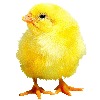|
The Button Quail we know today, is not really a button quail. Button quail are small running birds that
resemble quail, but are actually hemipodes. The birds, that this site and so many others are dedicated to are Chinese Painted
Quail. This quail first became popular in the late 1800's and early 1900's from Europeans vitisting the orient. They were
thought to bring good fortune to those who kept them. They were brought back to europe, and kept on the bottom of aviaries
as scavengers. In the 1940's, they were nicknamed "Button Quail" by the American soldiers who saw them in English aviaries.
Naturally, they are found in the low-elevation areas [under 4,000 feet] from southern China to India.
Despite their size, they consume large ammounts of water and prefer to nest near a source of it, and are commonly found in
rice paddies and marsh lands. Although little is know of wild buttons, it is known that they feed on grass seeds and various
other seeds along the floor. Allthough buttons can fly, they are ground dwelling, as they cannot perch.
In gerneral, button quail are very easy keepers. All they need is constant acces to food and water,
a place to hide, and a good ammount of groundspace to run around on. Because they do not perch, you can keep them in low-roofed
aviaries, but be sure that the roof is soft so they wont boink their heads, as they tend to bolt up when scared.
Button quails should be fed a game bird crumble, not bird seed. They also like to scavenge around for small
insects or dropped food, so a solid cage bottom is recomended. I give mine meal worms as a snack as well as bits of cooked
egg and fresh veggies. I do have to admit that the veggies are more of a play thing than a food source.
When the birds are kept together sometimes they will feather pluck and be aggressive towards eachother. Giving
them something fun to eat like mealworms or lettuce every other day may get them to stop, but if the problem is persistant,
you may need to separate the aggressive bird.
|

